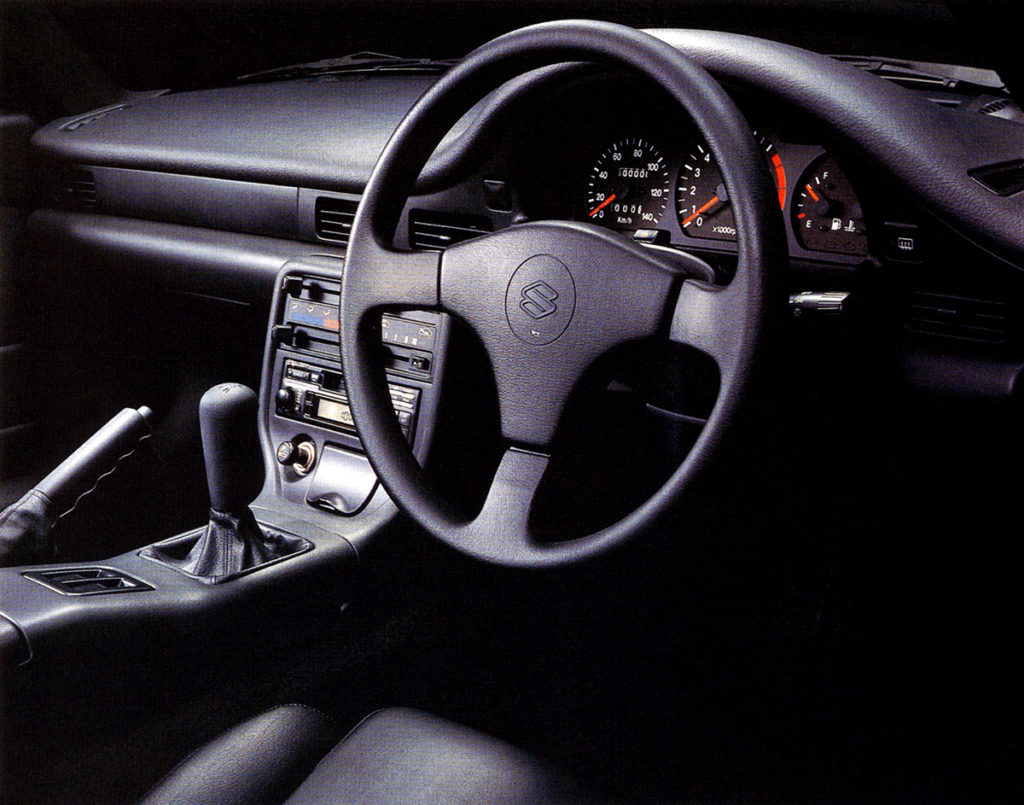The idea of a micro-sports car almost seems at odds with the modern automotive world. It’s a niche that Japan has always embraced thanks to restrictive kei-car regulations and, while few ever escaped onto the international market – such as the Japan-only Honda Beat – the Suzuki Cappuccino did.
Built at Suzuki’s Kosai factory, it went on sale in Japan in November 1991, becoming the company’s first (and only) sports car. It might have looked cute and cuddly, but this was a car that had been engineered to entertain. Within its tiny dimensions beat a turbocharged 656cc three-cylinder heart. Not your standard kei-car unit, but a highly balanced 12-valve twin-cam that produced 63bhp (the limit for kei-cars) and would happily rev all the way to 9300rpm!
Mounting it a long way back in the engine bay ensured near-50:50 weight distribution, and a five- speed manual gearbox sent drive to the rear wheels. A limited-slip differential was optional in Japan, too. It wasn’t just lean at 725kg, but lightweight where it counts the most. The Cappuccino features aluminium double wishbones up front, a compact and lightweight multi-link set-up at the rear, and alloy wheels with narrow tyres to keep unsprung weight to a minimum, also making the unassisted steering a joy. The bonnet and removable roof panels are also alloy.

Roof panels? Rather than a soft-top, it employs a modular removable hardtop. The panels lift out and store in the boot, with the roll-bar and glass rear screen then sliding down into the car. Clever. After discussions, Suzuki’s British importer convinced the company to homologate the car for sale in the UK. It appeared at the 1992 British motor show and went on sale a year later at £11,995.
By 1995 only 1110 Cappuccinos had been officially imported and registered in the UK – 888 red and 222 in silver. A small number made it to mainland Europe. After that, imminent emissions regulations would have necessitated the re-homologation of the car to continue sales here, which was simply not viable.
It was revised for 1996 in Japan, however, with a new, slightly torquier and lighter alloy-block version of the engine. Some of these later cars also got power steering and the option of automatic transmission. Production came to an end in 1997, with the final Japanese cars selling in 1998. In total, only 28,010 Cappuccinos were built.

It quickly gained a cult following around the world, but support for the Cappuccino has always been particularly strong in the UK. Numbers have certainly thinned out over the last decade but it remains a car that enjoys a die-hard following, with plenty of grey imports making their way here over the past 20 years.
Drive one, and you’ll understand why. This is a seriously entertaining little car, which delivers more driver enjoyment than its cheeky styling and modest power output would have you believe. One of the key elements is its compactness, which means it is a joy on British B-roads as well as city streets – it makes an MX-5 feel bulky! The lack of weight and surprising balance give this car the feel of a proper little thoroughbred. More ‘espresso’ than ‘cappuccino’, if you ask me.

Suzuki Cappuccino Common problems
• Engines are reliable but require very regular maintenance, with 3000-mile oil changes.
• Gearbox synchros are notoriously weak, so check for crunches.
• Those modular aluminium roof panels are prone to getting knocked about, so inspect them for any dents.
• Look for rust. Sills and wheelarches are the first giveaway, but a very thorough poke about underneath is advised.

What to pay?
Rough cars are normally best avoided, but can be bought for very little. Running and driving cars that need a little love start from about £2000, with most below that price usually broken for spares.
Spend around £4000 and you’ll get a well-maintained car in great condition, while £6000-8000 is about what you’ll pay for a low-mileage or freshly imported car; more for something particularly special.
UK cars don’t carry a premium – condition is the most important factor – but the JDM cars can have patchy histories, so a UK-supplied car is often a safer bet.




